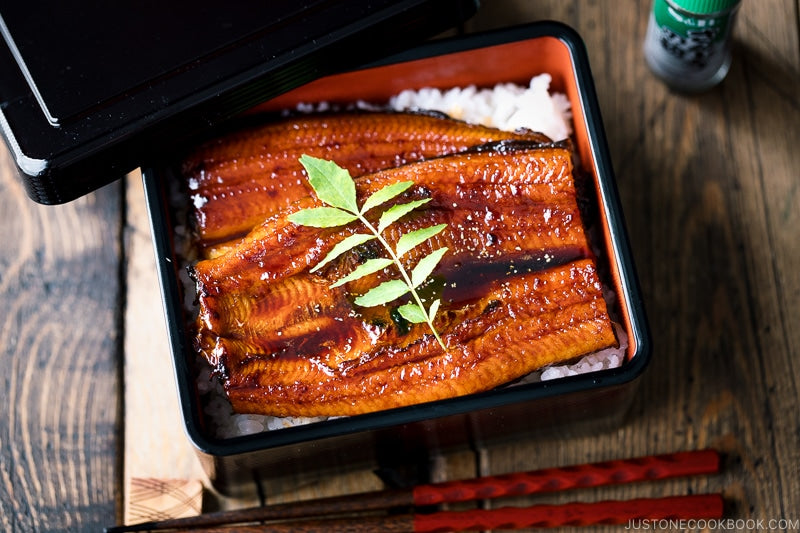

Unagi sushi is a mainstay item at most sushi restaurants, but have you tried unagi rice bowl before? This classic Japanese dish is called Unadon (鰻丼) or Unaju (鰻重), or you might have known it as eel rice.
The Japanese have a special affection for Unadon because the satisfaction of eating perfectly grilled unagi over a bed of warm rice is incomparable. Oh, and the aroma of the sweet caramelized sauce…that alone is enough to make my mouth water. 
What is Unadon (Unaju)?
Unadon or Grilled Eel Rice Bowl is a beloved Japanese dish consisting of steamed rice topped with grilled eels that are glazed with a sweetened soy-based sauce (called tare) and caramelized, preferably over a charcoal fire.
When grilled unagi is served in a big rice bowl called donburi, we call it Unadon (鰻丼), a short for unagi donburi. When the unagi is served in a fancy rectangle lacquered box with the lid on, we call it Unaju (鰻重) because these boxes are called jubako (重箱).
How Eels Are Cooked
This particular cooking method is known as Kabayaki (蒲焼), similar to Teriyaki. It’s a very common way to prepare eels and other fish in Japan.
This is how the unagi-specialized chefs prepare the eels. Live eels are split down the back (or belly), gutted and boned, butterflied, and cut into square fillets. Then the fillets are skewered, dipped in a sweet soy-based sauce, and broiled on a charcoal grill.
In the Tokyo region, the skewered eel is first broiled without the sauce, and we call it Shirayaki (白焼き). Then the unagi is steamed, before being dipped in the sauce and grilled again.
Dining at Unagi Restaurant in Japan
When you go to unagi specialized restaurants in Japan, the menu typically offers both Unadon and Unaju and there are 3 ranks for the price whether you order Unadon or Unaju.
- The premium grade is called Tokujo (特上) or Matsu (松, pine)
- The superior grade is called Jo (上) or Take (竹, bamboo)
- The average grade is called Nami (並) or Ume (梅, plum)
According to the unagi restaurants, the price is usually related to the weight (amount) of unagi and not necessarily the quality of unagi.
Tradition: Eat Unagi on Mid-Summer Day
Unagi (freshwater eel) is considered an expensive delicacy in Japan, and it’s not an everyday dish. I did a quick research and found out that 26.2% of people eat unagi “about once every 6 months”, followed by “once every 2 to 3 months” at 16.8%, “less than once a year” at 16.1%, and “once a year” at 15.8%.
So when do most people eat unagi? You will see big banners and carts of eel packages in the supermarkets right before the mid-summer day.
From Edo Period (1600-1850), we have a tradition of eating unagi on a particular mid-summer day called doyō-no ushi-no-hi (土用の丑の日) in order to gain stamina to beat the heat. In 2021, it falls on to July 28th.
Rich in vitamins A and E, and Omega-3 fatty acids, the great nutritious benefits of eel is another reason why Japanese people enjoy eating unagi.
How to Make Grilled Eel Rice Bowl at Home
Ingredients You’ll Need
- Unagi (Eel) fillets
- Unagi sauce – you can get a bottle of eel sauce but it’s SO easy to make it at home (I’ll show you!)
- Steamed rice
Japanese home cooks don’t buy a live eel to cook at home. They buy pre-grilled eel fillets and just reheat them before serving. Here in the US, you can purchase grilled eels that have been vacuum-sealed in Japanese/Asian grocery stores or this online shop.
Overview: Cooking Step
- Prepare the homemade eel sauce (see below).
- Broil eel fillets and brush the eel sauce right before taking them out.
- Serve rice in a large rice bowl (donburi), brush with sauce, and serve eel fillets on top.
How To Make Homemade Eel Sauce (Unagi no Tare)
Today I will share how to prepare Unadon with my homemade eel sauce (unagi sauce). You can buy a bottle of unagi sauce at a Japanese/Asian market, but you can easily make it at home. All you need is soy sauce, mirin, sake, and sugar!
With just 4 ingredients, you can quickly whip up a sweet caramelized sauce to flavor the grilled eel. If I have any leftover unagi sauce, I’ll also use it to brush on my grilled rice balls to make Yaki Onigiri.
What to Serve With Unadon
You can serve it with miso soup, some kind of pickles, and some small sides such as Spinach with Sesame Sauce or Kinpira Rekon.
It takes minimal effort to make delicious unadon, and it’s truly worth it to prepare this dish at home!
INGREDIENTS
cooking spray (or neutral-flavored oil, for broiling)
For the Unagi Sauce (enough for 2 fillets; double or triple the amount for extra sauce)
¼ cup mirin (or substitute 3 parts sake or water + 1 part sugar)1½ Tbsp sake (or substitute Chinese rice wine or water)
2½ Tbsp sugar
¼ cup soy sauce (use GF soy sauce for gluten free)
For Serving
Japanese sansho pepper (optional)INSTRUCTIONS

To Make the Unagi Sauce
1.To a small saucepan, add the mirin, sake, and sugar.
2.Set the saucepan on the stove over medium heat and whisk the mixture together. Then, add the soy sauce and bring the mixture to a boil.

3.Once boiling, reduce the heat to maintain a gentle simmer; you should see small bubbles around the edge of the pan. Continue simmering until the liquid is reduced to roughly one-third of the original amount, about 10-15 minutes. Tip: To check how much the sauce has reduced, dip the tip of a wooden chopstick into the liquid to mark the original amount; then, insert the chopstick again later to compare the sauce level against the original mark.

4.Toward the end of cooking, the sauce will thicken and you will see more bubbles. Use the chopstick to confirm that the thickened sauce is one-third of the original amount. Then, remove it from the heat. As it cools, the sauce will thicken more. Tip: If you feel you've reduced it too much, add a bit of water to loosen up the sauce; you also can simmer it again a bit more to get the right consistency.

To Cut the Unagi
1.Cut the unagi fillet in half or thirds to fit the size of your donburi serving bowl.
To Broil (recommended)
1.Preheat the broiler* on High (550ºF/288ºC) for 5 minutes with a rack placed about 8 inches (20 cm) away from the top heating element (in the center of the oven). *The broiler settings are Low (450ºF/232ºC), Medium (500ºF/260ºC), and High (550ºF/288ºC). I usually broil on High (8 inches away) or Medium (6 inches away). When broiling, you don't control the temperature in the oven; instead, you control the distance between the broiler and the surface of the food. It's similar to using hotter and cooler zones on your grill.2.Line a baking sheet with foil for easy cleaning and brush or spray the oil onto the foil. Place the unagi pieces on the foil, skin side down. Broil the unagi until the surface is blistered a bit, about 5-7 minutes. Broil it on one side only; there's no need to flip it over.

3.Open the oven and brush the sauce on top of the unagi. Then, broil again for 30-60 seconds until you see the sauce bubbling on top.

To Bake
1.Preheat the oven to 425°F/218ºC with a rack placed in the middle position. Line a baking pan with parchment paper and place the unagi pieces on top. Bake until the surface is blistered a bit, about 10-12 minutes. Bake on one side only; no need to flip. Brush the sauce on top of the unagi. Then, bake again for 30-60 seconds until you see the sauce bubbling on top.To Heat in a Pan
1.Prepare two 16 inch x 16 inch (40 x 40 cm) sheets of aluminum foil. Thinly spread some oil in the center of each sheet. Place two pieces of unagi on a sheet of greased foil. Bring the top and bottom foil edges together above the unagi. Fold and press the edges together a few times. Then, tightly close either side of the foil to form a sack. Repeat this process for the other unagi pieces. Add the foil pouches to the pan and reheat on low heat for 5-8 minutes. Tip: Your unagi won't blister or char if you use this method.To Serve
1.Serve the hot steamed rice in individual bowls. Then, pour or brush some of the unagi sauce on top of the rice.
2.Next, place one portion of the unagi on the rice in each bowl. Pour or brush more sauce on top of the unagi. Since I had a kinome (Japanese sansho pepper leaf), I placed it on top for garnish (optional). Serve immediately. You can also sprinkle ground Japanese sansho pepper on top (optional).

3.To serve in a jubako (Japanese lacquered box), place a bed of hot rice in the box and brush some unagi sauce on top. Then, place 2 pieces of unagi (the entire fillet) on top, with the pieces overlapping each other and covering the rice. Brush more sauce on top of the unagi pieces and serve.

